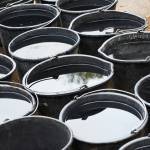Water Quality for Horses

Horses and other livestock almost never drink pure water. Instead, they usually have access to water that contains some level of bacteria, viruses, protozoa, algae, and minerals. Below a certain level of contamination, this water has no discernable negative effect. However, drinking water of extremely poor quality may impair health and reproductive capability, and can even be fatal to livestock.
The Australian and New Zealand Environment and Conservation Council (ANZECC) has updated its guidelines for livestock drinking water quality. The guidelines suggest levels of contamination from various sources that should not be exceeded if risk to animal health is to be avoided. Some recommendations are different from those used in other countries.
Water contaminated with cyanobacteria (blue-green algae) contains toxins that can cause liver damage in all types of livestock, including horses. Ground water sources that are contaminated by fertilizer are most likely to support the growth of cyanobacteria. Limiting the runoff of fertilizer into ponds and streams is the best prevention strategy. Horses should be provided with another source of water until the algal growth can be cleared.
Bacterial, viral, and protozoal contamination is common in ground water, but not all of these organisms are pathogenic. Testing for each specific type of contaminant is not usually practical, but a test to show the level of thermotolerant coliforms can give an indication of overall microbial contamination. Tests should be run periodically, as levels can change due to various conditions. Drinking water for livestock should contain less than 100 thermotolerant coliforms per 100 ml.
Minerals are present in most water. Extremely high concentrations of some minerals can cause chronic or toxic effects in livestock. Calcium concentrations up to 1,000 mg/L are acceptable if phosphorus levels are adequate. Water containing less than 400 mg/L of nitrate is generally safe, while a level over 1500 mg/L may be toxic. In horses, nitrite is 10 to 15 times more toxic, and concentrations of nitrite exceeding 30 mg/L may be hazardous to animal health. Nitrate can be converted to nitrite in the horse’s cecum. However, horses are much more resistant to nitrate toxicity than ruminants.
Nitrite causes displacement of oxygen on the hemoglobin molecule, reducing oxygen transport to tissues and resulting in respiratory distress. Runoff of manure and fertilizer from agricultural land is the most important cause of high nitrite levels in ground water.
Horses show no ill effects from drinking water with a salinity level up to 4,000 mg/L. Between 4,000 and 6,000 mg/L, they may initially be reluctant to drink and may develop some diarrhea, but will usually adjust without a health impact. Salinity above this level can be expected to cause problems and water with fewer dissolved solids should be provided.
There is a potential in rural areas for pesticide residues to contaminate water sources because of surface runoff, spray drift, or accidental spillage. The ANZECC water quality guidelines state that, in the absence of information derived specifically for livestock, drinking water guidelines for humans should be followed.
Drinking water for livestock should be tested periodically for various contaminants even if horses and other livestock do not show signs of disease or toxicity, as water quality can be affected by local events or even by conditions occurring in distant parts of a water system.








